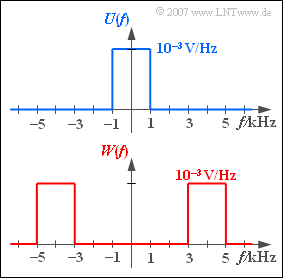Exercise 4.2: Rectangular Spectra
We consider two signals $u(t)$ and $w(t)$ with rectangular spectra $U(f)$ and $W(f)$ respectively.
- It is obvious that
- $$u(t) = u_0 \cdot {\rm si} ( \pi \cdot {t}/{T_{ u}})$$
- is a low-pass signal whose two parameters $u_0$ and $T_u$ are to be determined in subtask (1) .
- In contrast, the spectrum $W(f)$ shows that $w(t)$ describes a bandpass signal.
This task also refers to the bandpass signal
- $$d(t) = 10 \hspace{0.05cm}{\rm V} \cdot {\rm si} ( 5 \pi f_2 \hspace{0.05cm}t) - 6 \hspace{0.05cm}{\rm V} \cdot {\rm si} ( 3 \pi f_2\hspace{0.05cm} t)$$
whose spectrum was determined in task 4.1 . Let $f_2 = 2 \ \rm kHz.$
Hints:
- The task belongs to the chapter Differences and Similarities of LP and BP Signals.
- Consider the following trigonometric relationship in the solution:
- $$\sin (\alpha) \cdot \cos (\beta) = {1}/{2} \cdot \big[ \sin (\alpha + \beta)+ \sin (\alpha - \beta)\big].$$
Questions
Solution
(1) The time $T_u$ ⇒ first zero of the LP signal $u(t)$ – is equal to the reciprocal of the width of the rectangular spectrum, i.e. $1/(2\, \text{kHz} ) \hspace{0.15 cm}\underline{= 0.5 \, \text{ms}}$.
- The pulse amplitude is equal to the rectangular area as shown in the sample solution for task 4.1 . From this follows $u_0\hspace{0.15 cm}\underline{= 2 \, \text{V}}$.
(2) Das Bandpass–Spektrum kann mit $f_{\rm T} = 4\, \text{kHz}$ wie folgt dargestellt werden:
- $$ W(f) = U(f- f_{\rm T}) + U(f+ f_{\rm T}) = U(f)\star \left[ \delta(f- f_{\rm T})+ \delta(f+ f_{\rm T})\right].$$
Entsprechend dem Verschiebungssatz gilt dann für das dazugehörige Zeitsignal:
- $$w(t) = 2 \cdot u(t) \cdot {\cos} ( 2 \pi f_{\rm T} t) = 2 u_0 \cdot {\rm si} ( \pi {t}/{T_{\rm u}})\cdot {\cos} ( 2 \pi f_{\rm T} t). $$
Die Grafik zeigt
- oben das Tiefpass–Signal $u(t)$,
- dann die Schwingung $c(t) = 2 · \cos(2 \pi fTt$ ),
- unten das Bandpass–Signal $w(t) = u(t) \cdot c(t)$.
Insbesondere erhält man zum Zeitpunkt $t = 0$:
- $$w(t = 0) = 2 \cdot u_0 \hspace{0.15 cm}\underline{= 4 \hspace{0.05cm}{\rm V}}.$$
Der Zeitpunkt $t=62.5 \,{\rm µ} \text{s}$ entspricht genau einer viertel Periodendauer des Signals $c(t)$:
- $$ w(t = 62.5 \hspace{0.05cm}{\rm µ s}) = 2 u_0 \cdot {\rm si} ( \pi \cdot \frac{62.5 \hspace{0.05cm}{\rm µ s}} {500 \hspace{0.05cm}{\rm µ s}}) \cdot {\cos} ( 2 \pi \cdot 4\hspace{0.05cm}{\rm kHz}\cdot 62.5 \hspace{0.05cm}{\rm µ s}) $$
- $$ \Rightarrow \hspace{0.3cm}w(t = 4\hspace{0.05cm}{\rm V}\cdot{\rm si} ( {\pi}/{8}) \cdot \cos ( {\pi}/{4})\hspace{0.15 cm}\underline{ = 0}.$$
(3) Richtig ist der Lösungsvorschlag 1:
- Vergleicht man die Spektralfunktion $W(f)$ dieser Aufgabe mit dem Spektrum $D(f)$ in der Musterlösung zu Aufgabe 4.1, so erkennt man, dass $w(t)$ und $d(t)$ identische Signale sind.
- Etwas aufwändiger ist dieser Beweis im Zeitbereich. Mit $f_2 = 2 \,\text{kHz}$ kann für das hier betrachtete Signal geschrieben werden:
- $$w(t ) = 4\hspace{0.05cm}{\rm V} \cdot {\rm si} ( \pi f_2 t) \cdot {\cos} ( 4 \pi f_2 t) = ({4\hspace{0.05cm}{\rm V}})/({\pi f_2 t})\cdot \sin (\pi f_2 t) \cdot \cos ( 4 \pi f_2 t) .$$
- Wegen der trigonometrischen Beziehung
- $$\sin (\alpha) \cdot \cos (\beta) = {1}/{2} \cdot \big[ \sin (\alpha + \beta)+ \sin (\alpha - \beta)\big]$$
- kann obige Gleichung umgeformt werden:
- $$w(t ) = \frac{2\hspace{0.05cm}{\rm V}}{\pi f_2 t}\cdot \big [\sin (5\pi f_2 t) + \sin (-3\pi f_2 t)\big ] = 10\hspace{0.05cm}{\rm V} \cdot \frac{\sin (5\pi f_2 t)}{5\pi f_2 t}- 6\hspace{0.05cm}{\rm V} \cdot \frac{\sin (3\pi f_2 t)}{3\pi f_2 t}.$$
- Damit ist gezeigt, dass beide Signale tatsächlich identisch sind ⇒ Lösungsvorschlag 1:
- $$w(t) = 10 \hspace{0.05cm}{\rm V} \cdot {\rm si} ( 5 \pi f_2 t) - 6 \hspace{0.05cm}{\rm V} \cdot {\rm si} ( 3 \pi f_2 t) = d(t).$$

